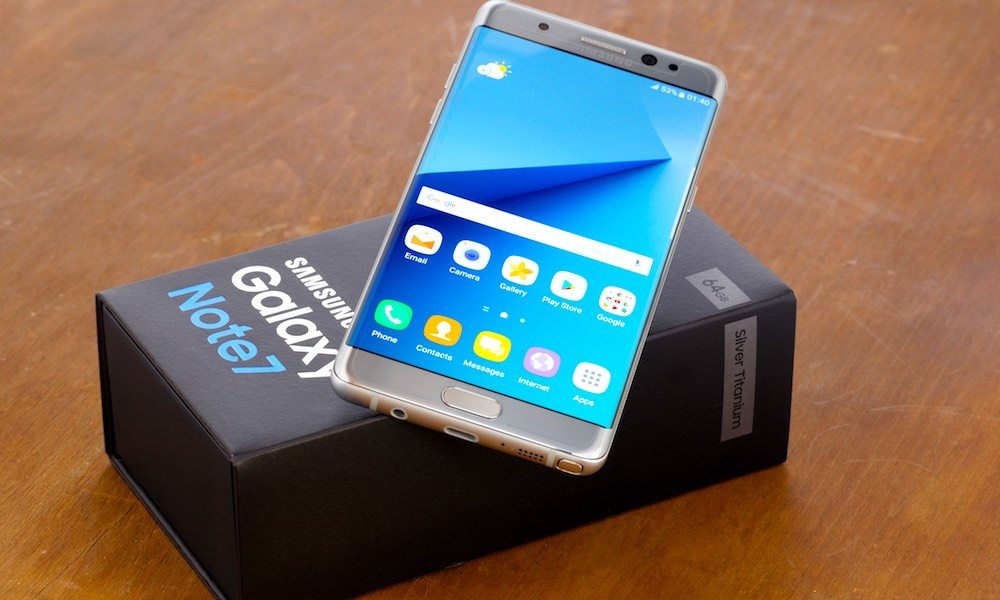iDrop News Exclusive Review: Samsung Galaxy Note 7

Toggle Dark Mode
Introduction
In light of the overwhelming success of its debut Galaxy S handset, which launched back in the summer of 2010, Samsung then endeavored to create a one-of-a-kind, revolutionary new device — one that not only defied conventional logic and technological wisdom, but that did so in a way as to successfully incorporate the various elements of function, performance, elegance, and ease-of-use like the world had never seen before.
And it’s with those sentiments in mind, that by October of the following year, Samsung’s Galaxy Note was born.
Boasting a gorgeous, 5.37-inch Super AMOLED display, albeit at a comparatively paltry 800 x 1,280 resolution, the original Galaxy Note was, for its time, an iconic, game-changing device to be reckoned with. Not only that, but it inherently set the stage, primarily in light of its equally overwhelming reception, for several successors that had quite the set of shoes to fill.
Yet the first Galaxy Note, much akin to the many successors that followed — even as well received as they were — suffered from an inherent deficiency in both material construction, flawed design, and were thwarted all the more by an onslaught of 3rd party bloatware, user interface shortcomings, and performance flubs — variables that collectively dogged the handset from becoming a true ‘iPhone killer’, as Samsung was often quick to suggest that it was.
Well it’s 2016 now, and, needless to say, Samsung has had plenty of time to learn from its mistakes over the last few years — and, evidently so, learn the company did.
Enter the all-new, dramatically redesigned Galaxy Note 7, which has officially dawned upon us — with all its grace, beauty, splendor, and raw processing prowess in tow.
Some might be quick to wonder, “well, what ever happened to the Galaxy Note 6?” And that question can easily be answered from both a marketing, as well as from a practical, logistical vantage point. In the case of the former, Samsung’s Galaxy Note 7 duly warrants the big step up to ‘7 series’ status — even if just to keep the device relevant from a marketing standpoint.
Yet in the case of the latter, Samsung’s Galaxy Note 7 represents such a dramatic leap forward in design, structural engineering, technological evolution, and overall user experience, that the South Korean company clearly saw it fit for skipping an entire generation on the naming spectrum.
And they made the jump for a pretty good reason, too!
Read on to find out more about Samsung’s latest, and, in my honest opinion, possibly the greatest handset that the company has launched to date.
Design & Materials
Marking a swift departure from the conventional plastic and “polished aluminum” (aka plastic) chassis of old, Samsung’s Galaxy Note 7 has essentially been reengineered from the ground up. The device is now a rock solid slab of metal and glass, boasting the latest generation of Corning Gorilla Glass 5 on both the front and back panels, with a tough aluminum frame holding it all together. Simply put, the Galaxy Note 7 feels nearly indestructible — yet its 5.96 ounce, feather-weight, super-slim profile make the phablet a pure joy to hold — especially for one-handed users like myself.

Unlike the Note 5, however — with its 6.03- x 3- x 0.30-inch footprint and 6.03 ounce weight, the Note 7 is considerably lighter, narrower, and easily pocketable — even despite its minimally different 6.04- x 2.91- x 0.31-inch footprint. The narrowing of the device has been achieved, in part, thanks to Samsung’s beautiful new dual-curved edge AMOLED display — which makes the handset appear, to the naked eye, almost bezel-less. And the Note 7 pretty much is just that, too — aside from an extremely thin sliver of color-coded metal lining either side of the display, which meets the aluminum shell at its edges.
Compared to the iPhone 6s Plus, the Galaxy Note 7 embodies a considerably narrower footprint — even despite its minimally larger, 5.7-inch screen, simply due to the gorgeous dual-curved edge design. It’s a truly beautiful design, I must say; and you really have to see it in person, or better yet, hold it in your hands, to fully appreciate its beauty.
I’ve owned both the original Note, as well as the Note 2, and I honestly have to say that the Note 7 doesn’t feel anything like either of them. This may be due, perhaps understandably, to its inherent shift in material construction; but whatever the case may be, the Galaxy Note 7 is clearly a testament to just how far Samsung has come with its design language.
Also, for what it’s worth, we’ve heard plenty of reports suggesting that Apple could be adopting a very similar design language for its 10th anniversary iPhone next year. So, if indeed that pans out to be the case, it should say quite a bit about how far Samsung has come.
Camera
While the iPhone has historically sported some of the best camera hardware (and software) money can buy, it’s my honest opinion that the Galaxy Note 7’s snapper gives the iPhone 6s a serious run for its money.
Boasting a comparative 12 megapixels, albeit with an f/1.7 aperture, Optical Image Stabilization (OIS), and LED flash, the Galaxy Note 7’s camera module produces some of the crispest, most vivid images I’ve ever seen on a smartphone before. Photos came out simply beautiful, and Samsung’s feature-rich camera software allows for the implementation of various filters and editing features to spruce them up even more after they’re taken.
Check out the Galaxy Note 7 photo samples below to get a better idea of what I mean. The last two shots are side-by-side comparisons between the Galaxy Note 7 and Apple’s iPhone 6s Plus; and, as you can see, even when cars were driving by on the Pacific Coast Highway at 65 miles per hour, photos came out remarkably less fuzzy on the Galaxy Note 7 than they did on the iPhone 6s Plus.
Specifications, Performance, Battery & User Interface
- Display:7-inch Super AMOLED Capacitive Touchscreen of 1,440 x 2,560 resolution; 515 pixels per inch; (79% screen-body ratio).
- OS: Android v6.0.1 (Marshmallow); Planned upgrade to v7.0 (Nougat).
- Chipset: Qualcomm Snapdragon 820 (MSM8996) (USA); Exynos 8990 Octa (International).
- CPU: Quad-core ‘Kyro’ (Dual-core 2.15 GHz; Dual-core 1.6 GHz) (Snapdragon); (Quad-core @ 2.3 GHz and Quad-core @ 1.6 GHz) ‘Mongoose’ (Cortex A53) (Exynos)
- GPU: Adreno 530 (USA); Mali T-880 MP-12 (International)
- Storage & Memory: 64 GB, with microSD card expansion (up to a 256 GB card); 4 GB RAM.
- Battery: Non-removable Li-Ion 3500 mAh battery; Fast battery charging; PMA wireless charging.
- Rear Camera: 12 MP — f/1.7 aperture, phase detection autofocus, OIS, LED flash, 4K video @ 30 fps; 1080p @ 60 fps; 720p @ 240 fps.
- Front Camera: 5 MP — f/1.7 aperture, 22mm, dual video call, Auto HDR.
- Connectivity:5mm headphone jack; USB Type C (v3.1); Wi-Fi 802.11 a/b/g/n/ac; Bluetooth v4.2; A-GPS; NFC.
- Sensors: Iris scanner; fingerprint scanner; accelerometer, gyro, proximity, compass, barometer, heart rate, SpO2
- : Always ON Display; TouchWiz UI; IP68 certified (dust proof and water resistant over 1.5 meter and 30 minutes); S Pen (stylus); Samsung Pay (Visa, MasterCard certified).
By far the most focal component of the Galaxy Note user experience is the device’s iconic S pen. Yet even the S pen, in its previous incarnations, wasn’t nearly as sophisticated, or deeply integrated, as the one employed on the Galaxy Note 7. Not only is the Note 7’s S Pen more powerful and accurate, but it can also write on the device’s screen while it’s submerged under water, and even when the screen is off, altogether.
Also unlike previous Note handsets, the Note 7’s S Pen can be inserted from either orientation; and it’s spring-assisted removal/insertion mechanism is a nice touch for those who want the assurance knowing that their pen won’t just fall out unexpectedly.
As one of the 400 million individuals globally who’re afflicted by hearing impairment, I sincerely appreciated the ability to simply whip out my Note 7, quickly retrieve the S Pen from its holster, and jot down notes on the screen — without even having to turn it on. This is a really cool feature, exclusive to the Note 7. Notes can even be deleted, or saved to Samsung’s proprietary Notes app while the screen is off, too.
Speaking of the screen being off, Samsung’s Galaxy Note 7 also features the Galaxy S7’s ‘Always On’ display — which shows a big clock, in addition to important notifications, even while the device isn’t actively being used.
Better yet, though, is when the screen is actually on — as it’s an absolutely gorgeous, immersive experience. Colors are crisp and vivid, thanks in part to Samsung’s Super AMOLED (active matrix organic light emitting diode) display, with its RGBRGB pentile matrix. The Note 7’s display is simply beautiful, and even more so without the thick bezels around the edges! Casemate, a firm that reviews new smartphone displays, actually pegged the Galaxy Note 7’s as one of the best displays that money can currently buy — so that should definitely say a lot.
I also really appreciated the considerably more minimal implementation of Samsung’s TouchWiz UI. In pervious installments of the Galaxy Note series, Samsung was prone to bundling a bunch of extra, unnecessary bloatware apps on the device — such as Amazon Kindle, Amazon MP3, and others — which not only took up equally unnecessary amounts of storage space, and slowed the device down, considerably so, but were hardly if ever used by most customers, anyways.
Aside from the removal of all that extra bloatware, Samsung’s TouchWiz UI on the Note 7 — backed by Android v6.0.1 (Marshmallow) — is both minimal and fluid. And that’s a lot to say, since previous incarnations weren’t nearly as smooth and easily navigable. All things considered, though: apps run smoothly, general touch gestures (scrolling, swiping, etc.) register quickly, and the S Pen can even be used for general UI navigation — which makes for a very seamless and lag-free experience.
The last Note device that I owned was the Note 2, and I specifically remember that device being plagued by a myriad of UI shortcomings — such as freezing up unexpectedly, or apps crashing, altogether. But using the Note 7 — so far, for a little over week now — I have not experienced any of the aforementioned UI issues, which is very much appreciated, and has made my experience with the Note 7 quite enjoyable.
To that end, the Note 7’s performance is light-years ahead of Notes past. Qualcomm’s Snapdragon 820 ‘Kyro’ CPU, coupled with 4 GB of RAM, ensures that the Note 7 is humming along on some of the latest and greatest silicon NOT produced by the folks up in Cupertino.
Sure, recent speed tests confirm that the Note 7 is no match when compared to the performance of Apple’s iPhone 6s; however, to be fair, the Note 7 is a different kind of device. And when you buy one, you’re buying the user experience, the software experience, and many other features that are exclusive to the Note 7. So as with everything in life, there are pros on cons on either side of the coin, right?
As I mentioned, however, the Note 7 has been running very smoothly for me; and in some instances, it has even shown better performance than my A9X-equipped iPad Pro.
Battery life is also amazing. My Note 7 lasted a good two days on a single charge; and while I wasn’t glued to it every waking moment during that testing time, I did download a few apps, watch a few shows on Netflix, and browsed/customized the OS. Also, the Note 7 features a slew of Android-enhanced battery saving options, which can be configured to your pleasing — including a really neat ‘blue light filter’ that can be implemented at all times, and, much like Apple’s Nightshift feature in iOS 9.3, makes for a much easier viewing experience on the eyes, at all times, while saving precious juice in the process.
The Galaxy Note 7 also features blazing-fast Samsung fast-charging technology. Or, for those who prefer to live life ‘cord-free’, the Note 7 also features speedy PMA wireless charging. I was easily able to go from about 45% battery, up to 90%, in just half an hour while plugged in; and from 50%, to about 85%, in a little over an hour, while using a wireless charging pad. Very impressed with that battery performance, I must say.
Unfortunately, however, I was informed that several users have reported issues with their Galaxy Note 7 batteries “exploding” unexpectedly while plugged in. So far, about 35 individual cases of the instance have been reported, according to Consumer Reports. And apparently, according to a text I received from my wireless carrier on Sunday, that statistic is significant enough to warrant a voluntary recall of the device.
Upon further investigation into the matter, I was able to find out that these effected devices were all plugged in and charging at the time of their spontaneous combustion, and that the instances are more than likely due to Samsung’s implementation of a new fast-charging standard that its batteries simply weren’t prepared to accommodate. I have not personally experienced this issue, likely because I switched from charging via USB to charging wirelessly (which happens at a much lower current than when the device is connected to an outlet via USB); and so, that being said, I’m not exactly sure at this point what’s going to happen.
As we recently reported, however, Samsung is currently taking steps to rectify the issue, and to ensure that future Galaxy Note 7 shipments aren’t afflicted accordingly. So this battery drama, much akin to Apple’s infamous ‘antenna-gate’ and ‘bend-gate’ issues with the iPhone 4 and 6, respectively, is likely to be addressed in a timely manner.
Security
Samsung’s Galaxy Note 7 is the first-of-its-kind device to feature an Iris scanner, a super-fast fingerprint reader, as well as additional layers of security — including a pattern, passcode, or PIN unlock — all on the same handset.
The Iris scanner, which may seem like something out of the X Files, is actually a quite effective way of unlocking the device. The only drawback to using it, as far as I can tell, is that you have to hold the Note 7 awkwardly close to your face for a few seconds while the front facing cameras register your irises — the thin, structural element of the human eye responsible for regulating the diameter of the pupil.
The fingerprint sensor on the Note 7, which is PayPal certified, also works even more quickly and effectively than Apple’s Touch ID — at least according to my testing. The only caveat is that, unlike Touch ID, you have to ensure that your finger is placed on the fingerprint reader (embedded in the home button), in just the right orientation, otherwise it might not register the first time around.
But when it does register, it registers quickly.
In addition to the Iris and fingerprint scanners, the Note 7, as I mentioned, also boasts additional layers of security — including a 9-point, finger-drawn pattern, PIN, or Passcode unlock — security tools that can be configured by going into the Settings menu.
The Galaxy Note 7 is also one of the first devices to feature a super-secure, Samsung Knox-powered “secure folder” — a separate folder on the device, which allows you to store things like files and apps, encrypted by additional layers of security. Additionally, the secure folder can even store separate Google accounts, photos of your personal identification documentation (i.e: your passport, driver’s license, or state-issued ID. In other words, Secure Folder can essentially be thought of as a place to store information or apps you don’t want anyone else accessing.
Conclusion
Samsung has had several years to work out many of the shortcomings that for long plagued its Note series of devices. And, that said, the Note 7 is a clear and well-oiled example that the company has learned from its mistakes over the years. Not only is the Galaxy Note 7 physically one of the most attractive, eye-catching devices I’ve ever laid my hands on — and I have a long and well-documented history of flipping through smartphones like flapjacks on a hot griddle at IHOP — but the Note 7 is also a testament to the fact that Samsung is actually listening to its customers.
Simply put, where previous Note handsets fell short — in some cases, miserably, the Note 7 came along and made almost every wrong, right.
Is the Galaxy Note 7 the best phone that money can buy right now? Well, that all depends on your personal preference, and, perhaps to a lesser extent, where the majority of your digital content calls home — on the iOS or Android platform.
Certainly the Note 7 is not perfect. Yet in an imperfect world, where technology evolves so rapidly that the sheer evolution thereof can easily make your head spin, the Note 7 delivers a plethora of one-two punches. Its robust security features, beautiful, solid design, and quality construction are quite pleasing, to say the least; and its powerful performance, S Pen, customization, and myriad of UI features are a pure joy to use.
Apple’s iPhone 7 will certainly give the Note 7 a run for its money, but needless to say the Galaxy Note 7 has raised the bar considerably. If you’re looking for an Android phone, the Samsung Galaxy Note 7 is hard to beat.










